Sick of wasting water (and money) on a high-maintenance front yard that just doesn’t hold up to the heat? You’re not alone. Drought-tolerant landscaping is more than a trend—it’s a smart solution that blends beauty with practicality.
If you think going drought-tolerant means settling for a dull, dusty yard, think again. With the right design, you can have a front yard that’s not only water-wise but also full of color, texture, and curb appeal. It’s all about using the right elements—think native plants, gravel, succulents, and smart layout choices.
In this post, I’ve pulled together 21 of the best drought-tolerant landscape ideas for your front yard. These aren’t vague design tips. These are real, actionable ideas you can actually use—whether you’re starting from scratch or just looking for a refresh.
You’ll find inspiration for all kinds of styles—from sleek and modern to warm and desert-chic. And no, you don’t need a landscape architect to pull these off.
Ready to turn your front yard into a stunning, low-water masterpiece? Let’s jump in.
1. Succulent Garden
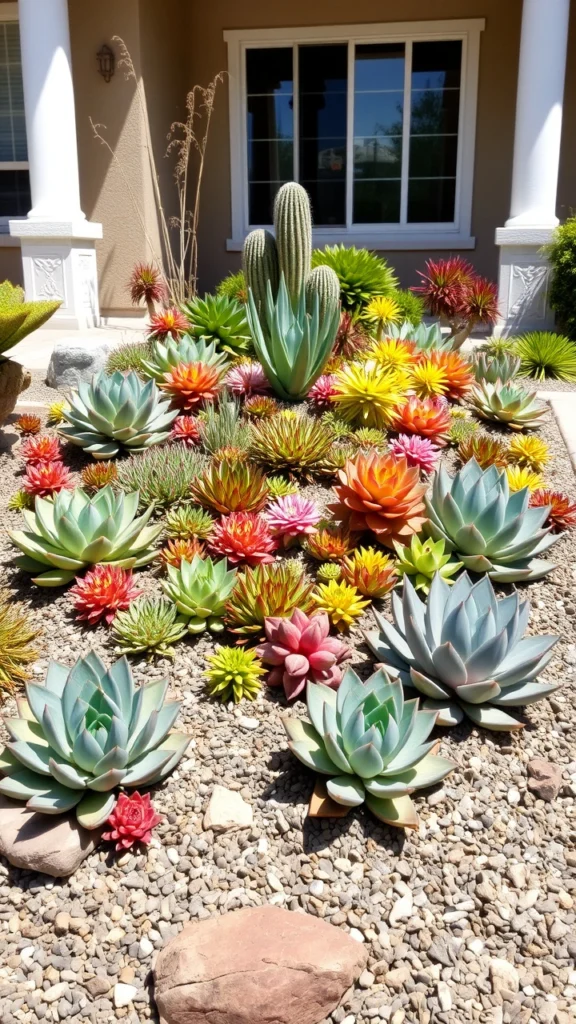
If you’re aiming for a front yard that’s low-maintenance but still packs visual punch, a succulent garden is a perfect fit. Succulents are champions of drought-tolerant landscaping. They thrive on minimal water, handle the heat like pros, and come in an amazing variety of colors, shapes, and sizes.
You can start small by grouping a few different varieties in a raised bed, or go big with a full front yard design built around succulents. Try mixing types like echeveria, sedum, and agave for texture and contrast. Want even more dimension? Add in some driftwood, decorative rocks, or a large boulder to anchor the look.
These plants also do great in well-drained soil, so consider adding sand or perlite to improve drainage. And if your front yard doesn’t get full sun all day, don’t worry—plenty of succulent varieties thrive in partial sun, too.
Once planted, a succulent garden is mostly hands-off. You’ll save on water, skip the mowing, and enjoy a yard that looks great year-round.
2. Xeriscape Design

Xeriscaping isn’t just a buzzword—it’s one of the smartest ways to create a front yard that’s both beautiful and sustainable. At its core, xeriscaping means designing your landscape to reduce or eliminate the need for irrigation. That means fewer watering sessions and more peace of mind during dry spells.
The beauty of xeriscaping is how flexible it is. You can use native plants, drought-tolerant perennials, gravel, mulch, and even hardscaping elements like flagstone or pavers to pull the look together. The key is to plan thoughtfully—group plants with similar water needs together, and design your layout so water naturally flows where it’s needed most.
Xeriscaping doesn’t mean sacrificing beauty. In fact, it often ends up looking more intentional and polished than a traditional lawn. It’s also a huge win for your wallet—lower water bills and less maintenance long term.
Whether you live in a dry climate or just want to garden smarter, xeriscaping is a front yard solution worth considering.
3. Cacti Collection
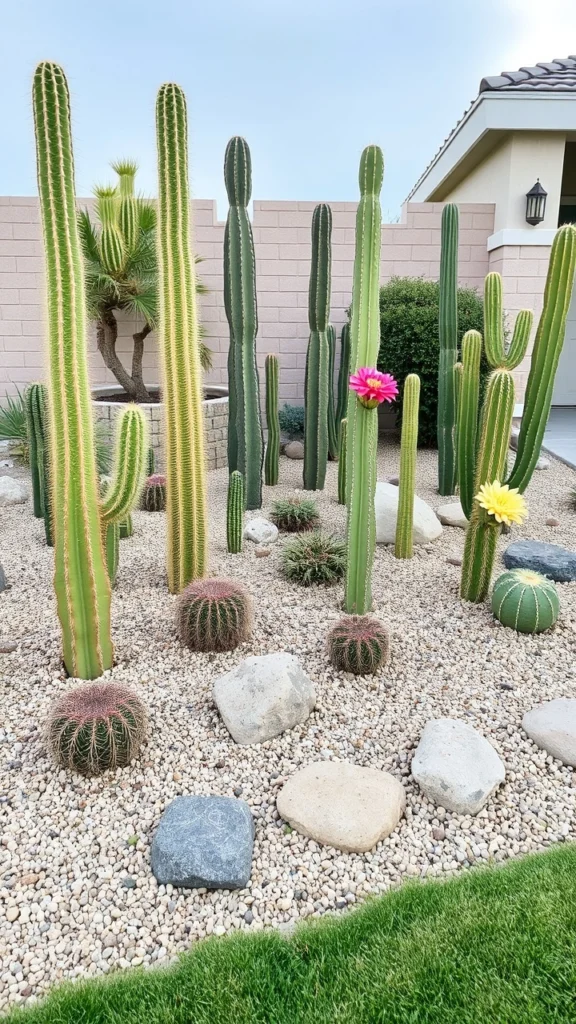
Want a bold, sculptural look that thrives on neglect? A front yard cactus collection might be your dream setup. Cacti are the definition of tough—they handle extreme sun, need almost no water, and look amazing doing it.
Designing a cactus-focused front yard is all about contrast and structure. Use a mix of heights and shapes—tall saguaro-style cacti, barrel cacti, prickly pear, and even flowering varieties like echinopsis. Space them out thoughtfully so each plant has room to shine.
Pair your cacti with sandy soil, gravel, or decomposed granite to create that classic desert vibe. And don’t forget to incorporate a few architectural elements—like a curved pathway, a stone border, or even a rusted metal planter for a modern twist.
Worried about safety? Keep the spiky varieties away from walkways or use containers to control placement. A cactus garden can be a minimalist’s paradise and a water-saver’s dream—all in one.
4. Gravel Paths
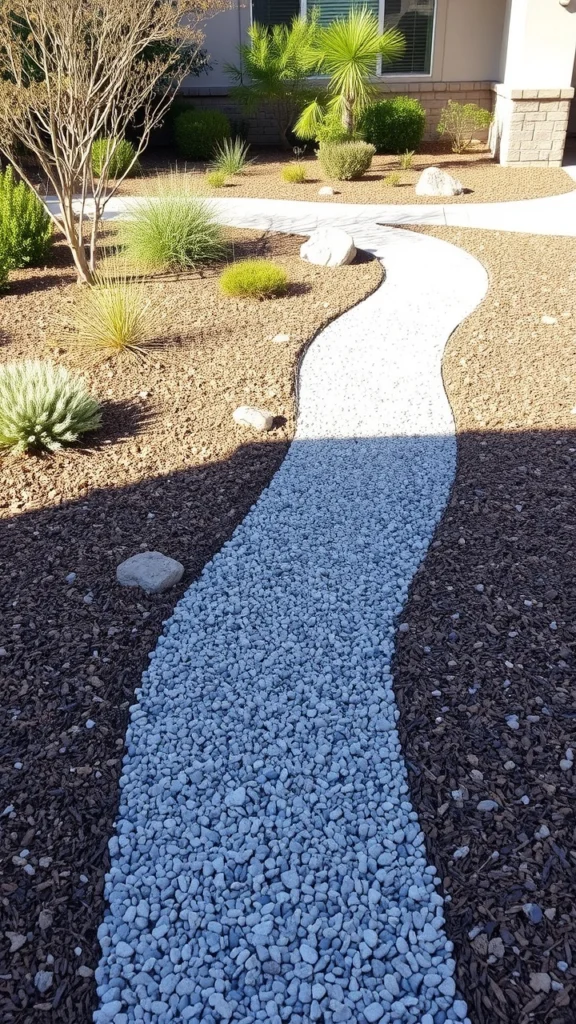
Gravel paths are a total game-changer when it comes to drought-tolerant front yard design. Not only are they low-maintenance, but they also add structure and flow to your outdoor space. Plus, they help with water drainage and cut down on muddy or dead patches of grass.
You can use gravel to define walkways, outline planting areas, or even replace large sections of your yard altogether. Go for pea gravel for a soft underfoot feel or crushed granite for a more solid, structured look. Pro tip: add a weed barrier underneath to keep things clean and tidy long-term.
Gravel comes in lots of colors and textures, so you can match the tone of your home—warm beige for a rustic vibe, or sleek gray for something modern. You can also edge your paths with metal strips, bricks, or native plants for an extra polished finish.
Best of all? No watering, no mowing, and practically zero upkeep. Gravel just makes sense.
5. Bermuda Grass

Yes, you can still have a lawn and be drought-conscious—Bermuda grass is proof. Unlike traditional turf varieties, Bermuda grass is incredibly heat- and drought-tolerant, making it a solid choice for front yards in warm, dry climates.
This grass loves full sun and recovers quickly even during dry spells. Once established, it needs far less water than cool-season grasses like fescue or bluegrass. It’s also dense and hardy, which helps it resist weeds and foot traffic.
To make the most of Bermuda grass, mow it regularly (but not too short), aerate once or twice a year, and water deeply but infrequently to encourage deep root growth. You’ll also want to fertilize during the growing season to keep that rich green color.
If you’re not quite ready to give up the look and feel of a traditional lawn but still want to conserve water, Bermuda grass strikes a great balance between beauty and efficiency.
6. Lavender Rows
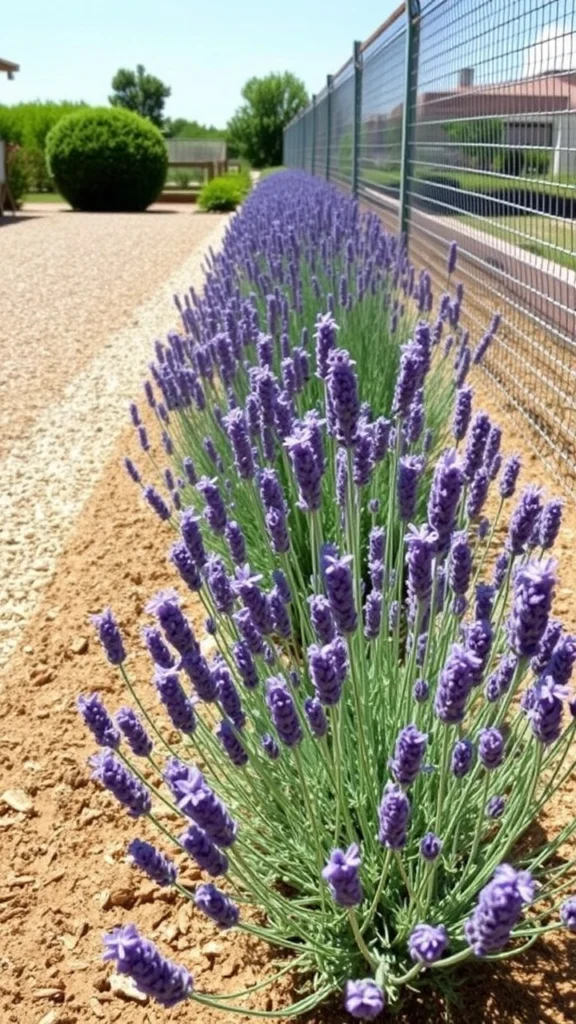
Lavender isn’t just beautiful—it’s a drought-tolerant powerhouse. Planting rows of lavender in your front yard creates an instant wow factor, and the best part? It thrives in dry conditions and poor soil. That means less watering, less fuss, and way more scent and style.
Lavender rows work great as borders along walkways, driveways, or fences. They add structure and symmetry, while also attracting pollinators like bees and butterflies. Choose varieties like English lavender (compact and cold-hardy) or Spanish lavender (flashier blooms and great for warm climates).
Spacing is key—give each plant about 12–18 inches to spread and breathe. Once established, lavender only needs occasional deep watering and a yearly trim to stay looking lush and full.
It’s also evergreen in many regions, so your yard keeps its charm year-round. And let’s not forget—fresh lavender can be harvested for homemade sachets, oils, or decor.
7. Mulch Bedding
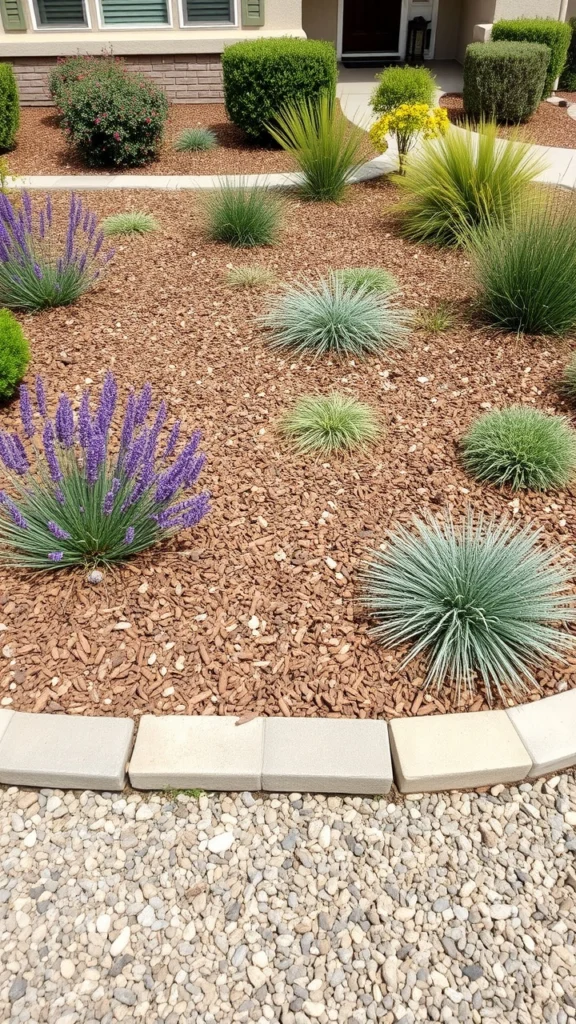
Mulch might not sound glamorous, but it’s one of the most effective tools in drought-tolerant landscaping. Adding mulch around your plants helps lock in moisture, reduce evaporation, and keep weeds at bay—all with minimal effort.
Start by choosing the right mulch: shredded bark for a natural look, or gravel mulch if you prefer a cleaner, modern vibe. Spread it about 2–3 inches thick around plants and trees, but avoid piling it up against the stems or trunks.
Mulch beds work especially well as a foundation layer for drought-resistant plants, shrubs, or even decorative accents like boulders and planters. They make everything look more intentional and well-maintained while doing the heavy lifting underground.
Bonus: mulch breaks down over time (if organic), improving soil quality and encouraging healthy plant growth.
8. Drought-Resistant Shrubs
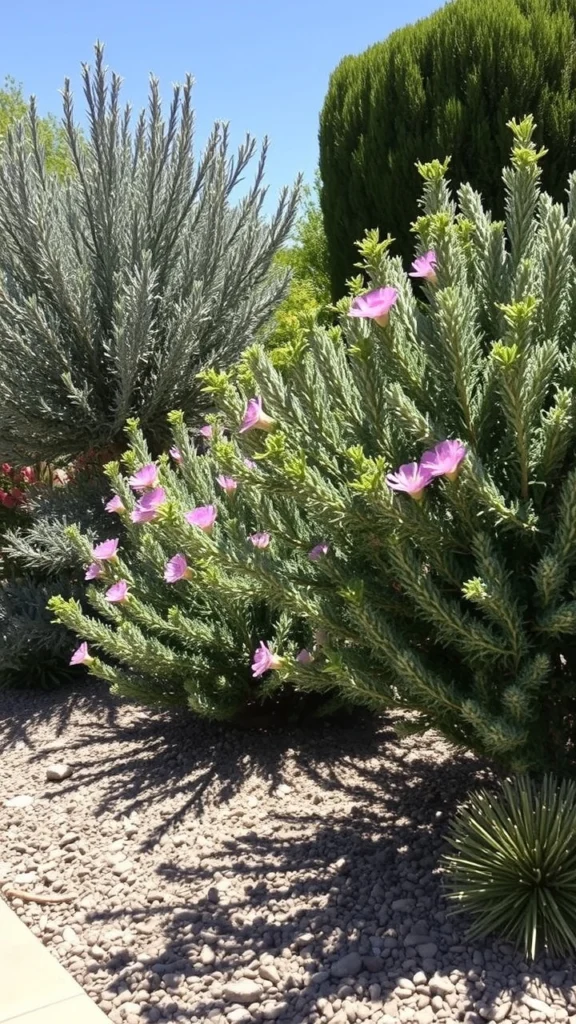
Shrubs are the unsung heroes of a low-water front yard. When you pick drought-resistant varieties, you get year-round structure, color, and privacy without the upkeep of a thirsty lawn or high-maintenance flowers.
Look for plants like rosemary, boxwood, oleander, or manzanita. These shrubs can handle tough conditions and still come out looking strong and vibrant. They work great as foundation plants near your home, as low hedges, or as filler in garden beds.
You’ll want to space them according to their mature size, and once they’re established, they’ll only need occasional deep watering. Prune them once or twice a year to keep the shape tidy.
Want a little more punch? Mix in flowering drought-resistant shrubs like butterfly bush or lantana to add color without increasing your water use.
9. Rocky Groundcover
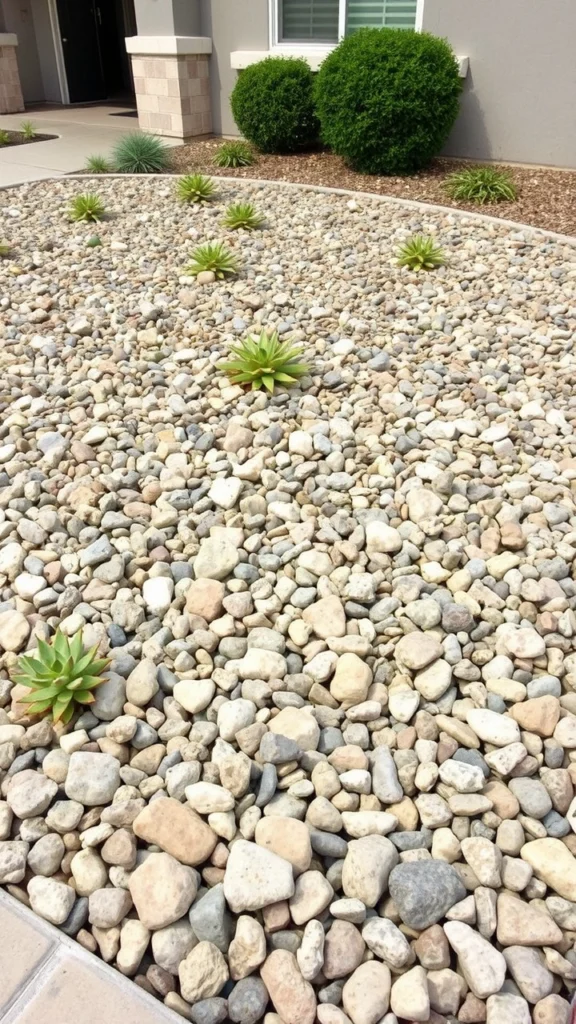
If you’re tired of grass but don’t want your front yard to look barren, rocky groundcover is a sleek, low-maintenance option. It’s ideal for hot, dry climates and works beautifully with other drought-tolerant landscaping features like cacti, succulents, and native shrubs.
Choose your rock type based on the look you’re going for—pea gravel for a soft, natural finish, crushed stone for a rugged vibe, or river rocks for something polished. Mix in stepping stones or pavers to create walking paths and break up the layout.
Rocks don’t just look great—they also help control erosion, suppress weeds, and allow rainwater to percolate into the soil. Just make sure to install a good weed barrier underneath to save yourself from headaches down the road.
It’s a one-time investment that pays off big time in water savings and curb appeal.
10. Perennial Grasses
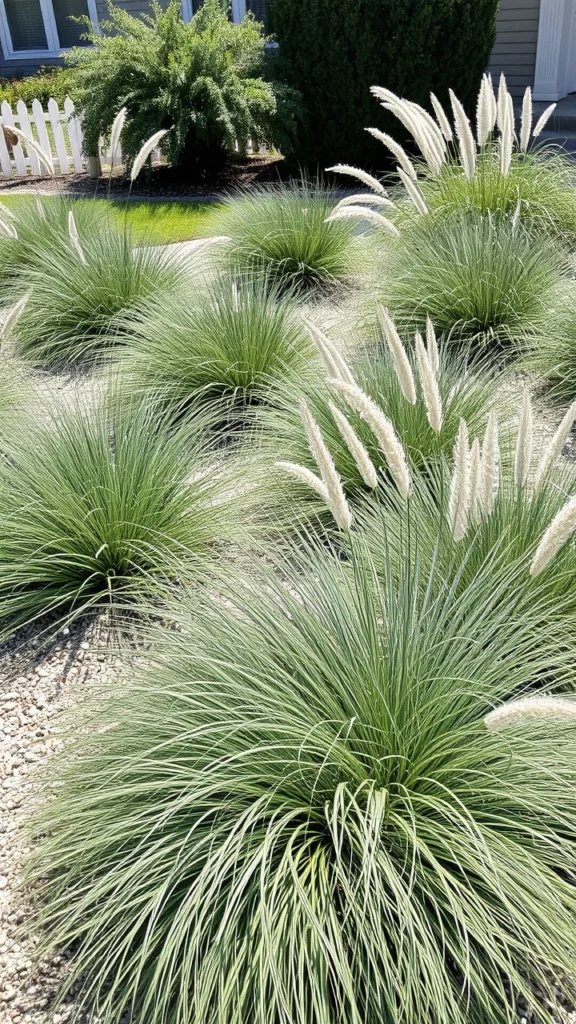
Want movement, texture, and low water needs all in one plant? Perennial ornamental grasses are your go-to. They’re resilient, require very little irrigation once established, and add an elegant, flowing feel to any front yard.
Some great options include blue fescue, fountain grass, and Mexican feather grass. These grasses work well in clusters, as borders, or mixed with wildflowers and rocks for a natural, breezy aesthetic.
They’re perfect for filling space without looking overcrowded. Plus, many of them change color throughout the year—greens in spring and summer, golden tones in fall and winter—so your yard stays interesting year-round.
Cut them back in late winter or early spring, and that’s pretty much it. These grasses are the definition of “plant it and forget it.”
11. Native Plants
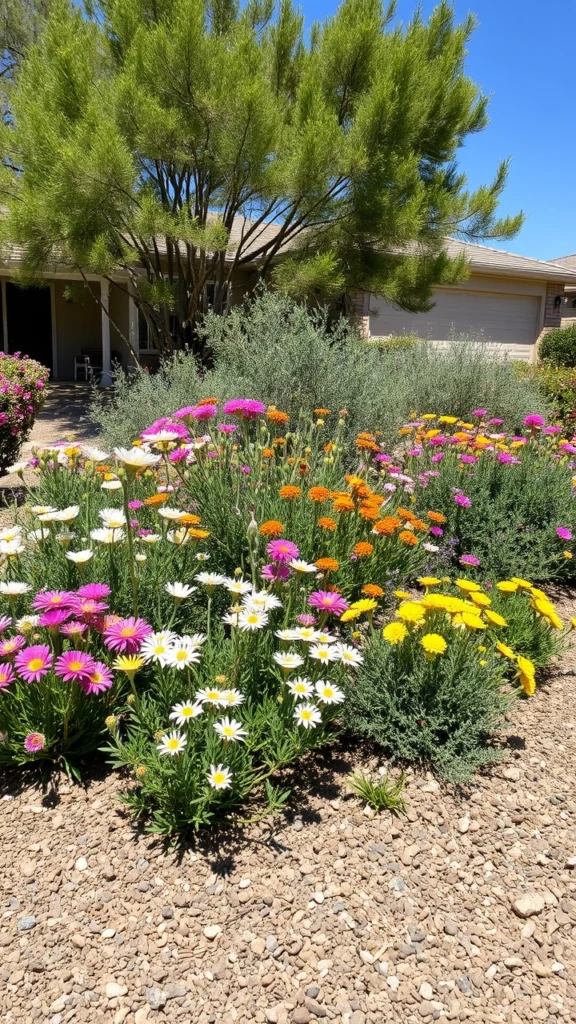
Using native plants in your front yard is one of the smartest moves you can make for a drought-tolerant design. Why? Because they’re already adapted to your local climate and soil, meaning they need way less water and attention to thrive.
Native plants also support your local ecosystem, attracting beneficial insects and birds. That’s a big win if you’re aiming for sustainability. Depending on where you live, native options might include California poppies, black-eyed Susans, or desert marigolds.
The best part? They don’t look “low-effort.” Many native plants are vibrant, hardy, and bloom beautifully with minimal maintenance. Plant them in groupings for visual impact, and pair with mulch or gravel to keep things neat and water-smart.
You’re saving water, supporting biodiversity, and still making your yard pop.
12. Zen Stone Garden
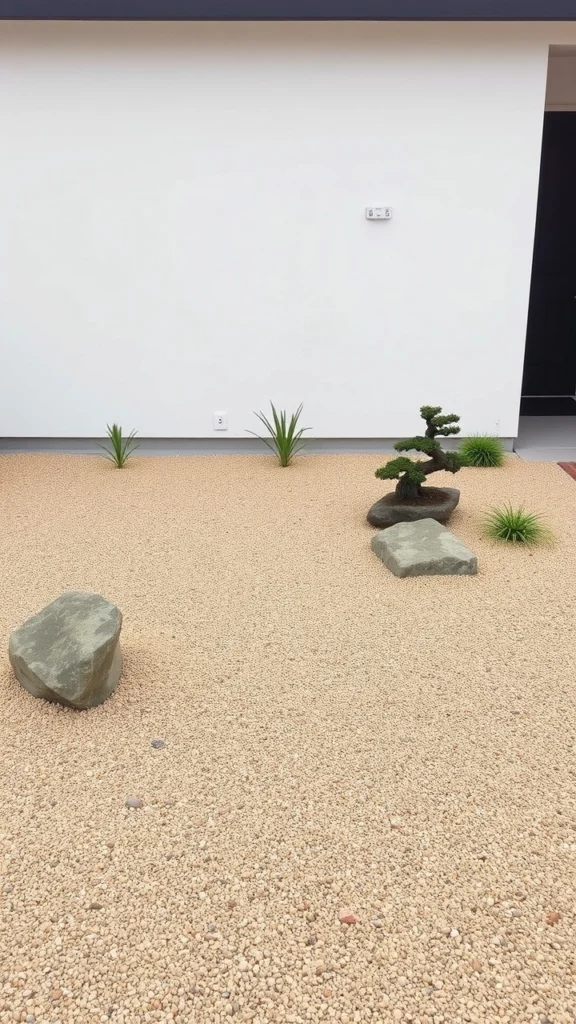
Minimalist, meditative, and extremely drought-friendly—a Zen stone garden brings peaceful vibes and almost zero watering needs to your front yard. Inspired by Japanese design, it focuses on simplicity and balance using rocks, gravel, sand, and carefully placed elements.
To create the look, start with raked gravel or sand as the base. Then add boulders, flat stones, and perhaps a few sparse plants like dwarf pines or compact succulents. The key is asymmetry and negative space—it’s all about calm and intention.
Zen gardens are perfect for small yards or corners that don’t get much foot traffic. They’re also incredibly low-maintenance once set up—no mowing, no irrigation, no stress.
Add a few stepping stones or a dry stream bed for a functional and beautiful twist.
13. Agave Plants
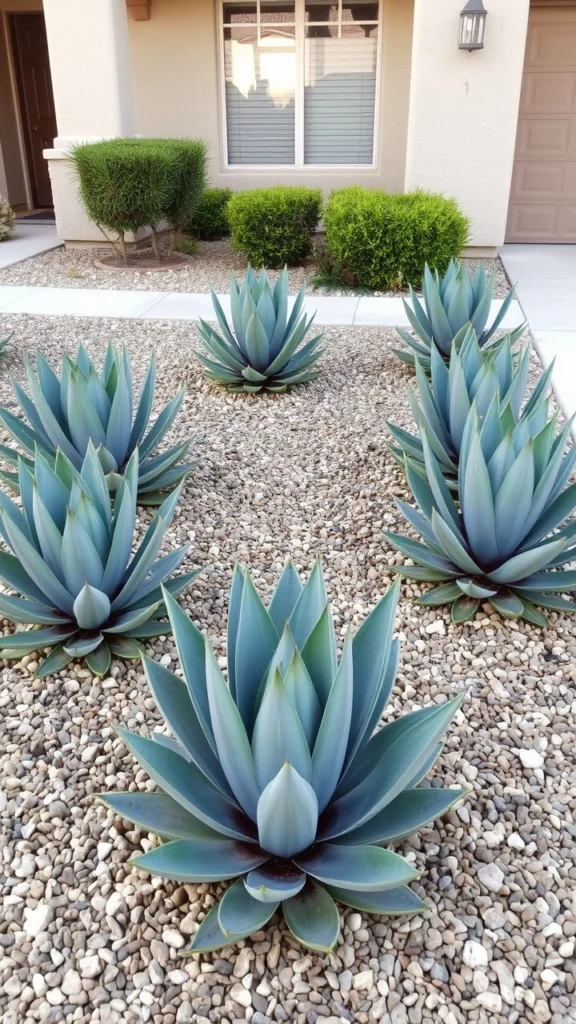
Agave plants are the rockstars of any drought-tolerant landscape. With their bold, sculptural shapes and thick, water-retaining leaves, they bring drama and structure to your front yard without demanding much in return.
Most agave species thrive in dry, rocky soil and need almost no watering once established. They’re perfect as focal points in gravel beds, rock gardens, or even lining a walkway. And while they look sharp (literally), they’re incredibly tough—resisting pests, disease, and neglect.
A mix of agave types—like the spiky Agave americana or the more compact Agave parryi—adds visual interest. Just be sure to give them space; these plants need room to breathe and show off.
Low effort, high impact. That’s the agave way.
14. Drip Irrigation
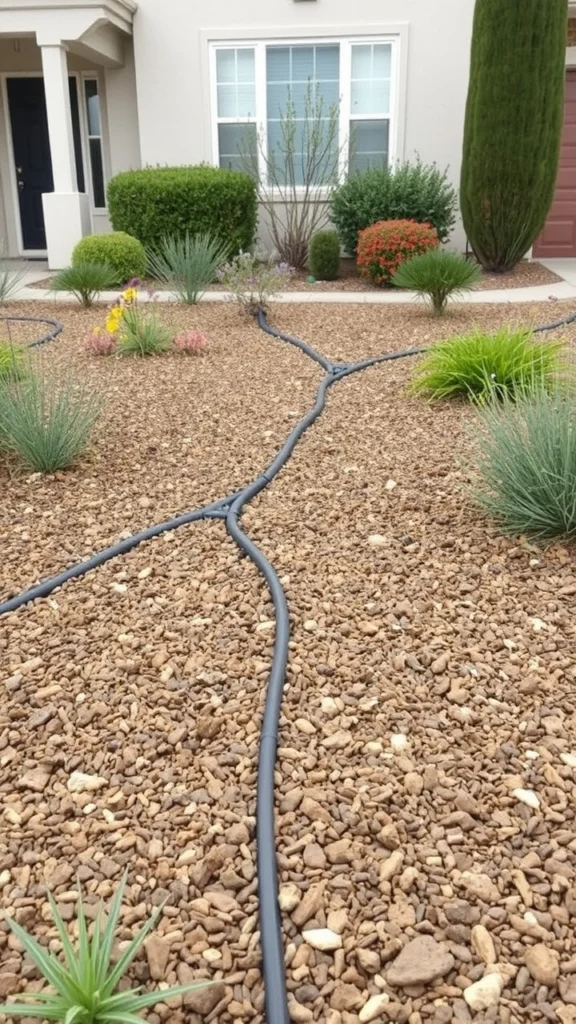
Even drought-tolerant yards need some water—just very strategically. That’s where drip irrigation comes in. It delivers water right to the roots of your plants, minimizing waste and maximizing efficiency.
Installing a drip system might sound technical, but it’s actually pretty straightforward. You lay a network of tubing across your yard, place emitters near the base of each plant, and set a timer to water early in the morning or late in the evening. Done.
Drip systems are ideal for beds with native plants, shrubs, or even vegetable patches. They keep water use low while helping your landscape thrive—especially in the early months when new plants are getting established.
It’s a smart, sustainable upgrade that pays for itself in water savings and healthier plants.
15. Wildflower Mix
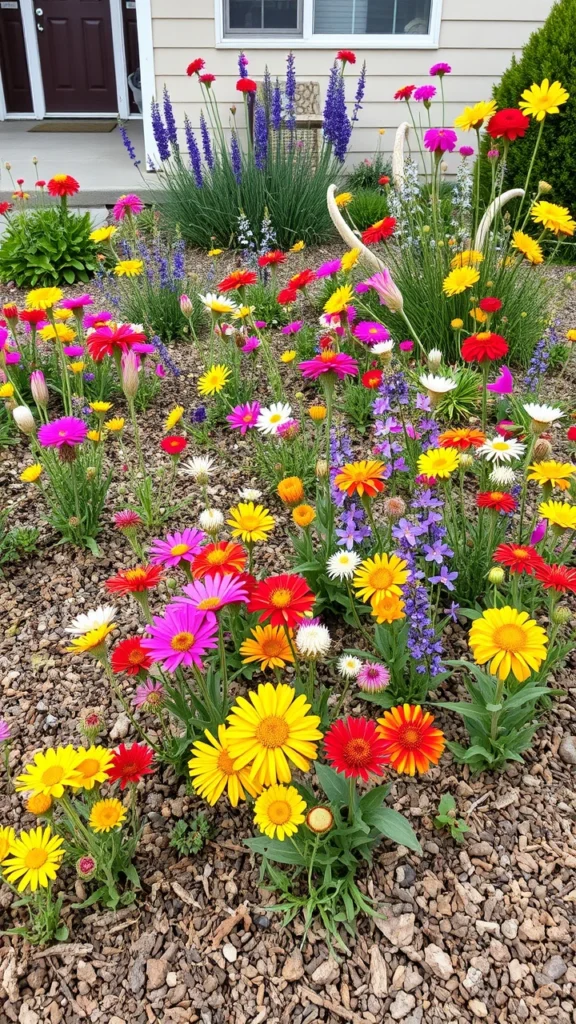
Want color, movement, and pollinator magic? Go wild—literally—with a drought-tolerant wildflower mix. It’s one of the most beautiful and low-maintenance ways to fill your front yard.
Choose a native or regionally appropriate seed blend, and sow it in spring or fall, depending on your climate. These wildflowers—like Indian blanket, desert bluebell, or California poppy—can thrive in dry conditions and poor soil once they’re established.
Not only will you get a natural, meadow-like look, but you’ll also draw in bees, butterflies, and even hummingbirds. It’s low water, high reward.
Plus, you can reseed each year or let nature do its thing. Either way, you’ll have a yard that feels alive, seasonal, and totally unique.
16. Yucca Plants
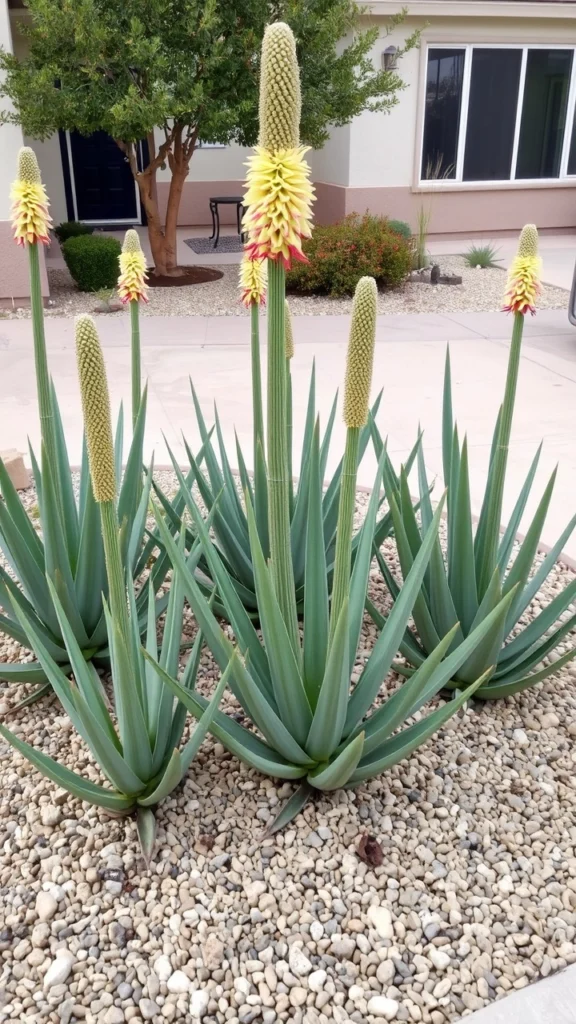
Yucca plants are desert royalty—bold, architectural, and practically indestructible. If you’re after that modern-meets-native look, these spiky beauties are your best bet.
Yuccas love full sun and dry soil. They store water in their thick leaves and need almost no maintenance once settled in. Plant them as statement pieces at your yard’s corners or mix them into gravel beds with agave and cacti for a stunning combo.
Some varieties grow tall and tree-like, while others stay compact—perfect for small spaces or container gardens. And when they bloom, their tall white flower stalks steal the show.
They’re sharp in more ways than one, so place them where foot traffic is low.
17. Bougainvillea Vines
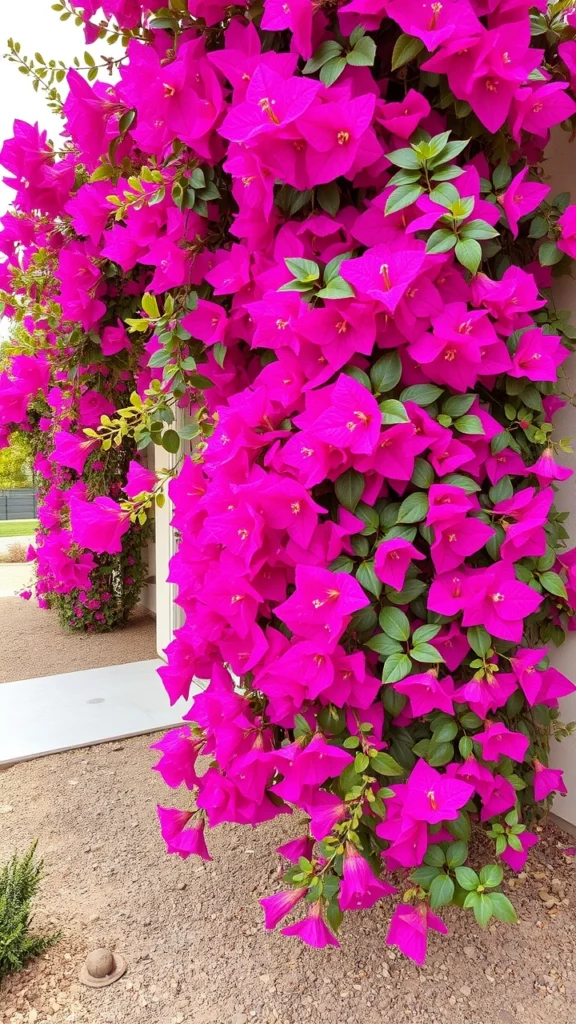
If you want to add a splash of vibrant color to your front yard with barely any water fuss, bougainvillea vines are your new best friend. These sun-loving climbers thrive in dry, warm climates and produce brilliant pink, magenta, orange, or purple blooms almost year-round.
Train them up a trellis, over a fence, or even let them cascade along a wall. They grow fast and bold, creating a dramatic focal point that instantly upgrades curb appeal.
Bougainvillea doesn’t like wet feet, so make sure the soil drains well. Once established, it hardly needs watering, and trimming it once in a while keeps it in shape. This is one of those plants that gives more than it takes.
Just be mindful—they’ve got thorns. So plant them somewhere pretty but not too close to where people walk.
18. Ground-Level Planters
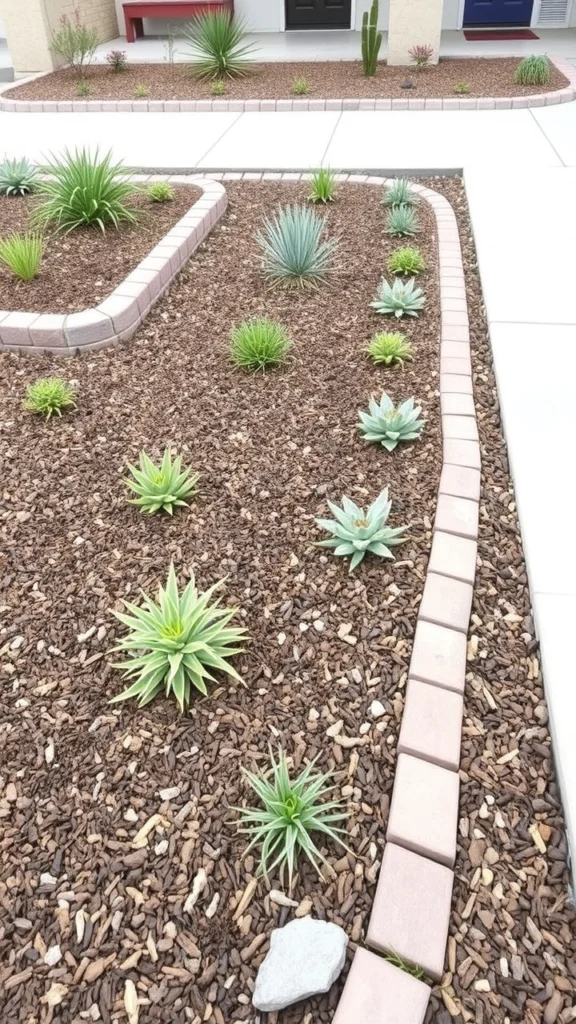
Ground-level planters are a smart way to create structure in your drought-tolerant front yard while keeping things organized and neat. These are basically raised beds without the “raised” part—built directly into the landscape using stone, concrete, brick, or wood edging.
They’re perfect for sectioning off native plants, succulents, or herbs in a clean and controlled way. Plus, they help you manage soil quality and watering more precisely.
Want low effort? Fill them with gravel, mulch, and drought-tolerant plants like lavender, sedum, or blue fescue. Want visual punch? Play with color contrasts or stagger multiple planters throughout your space.
The best part? They’re low-maintenance and give your yard a modern, intentional look.
19. Ornamental Grasses
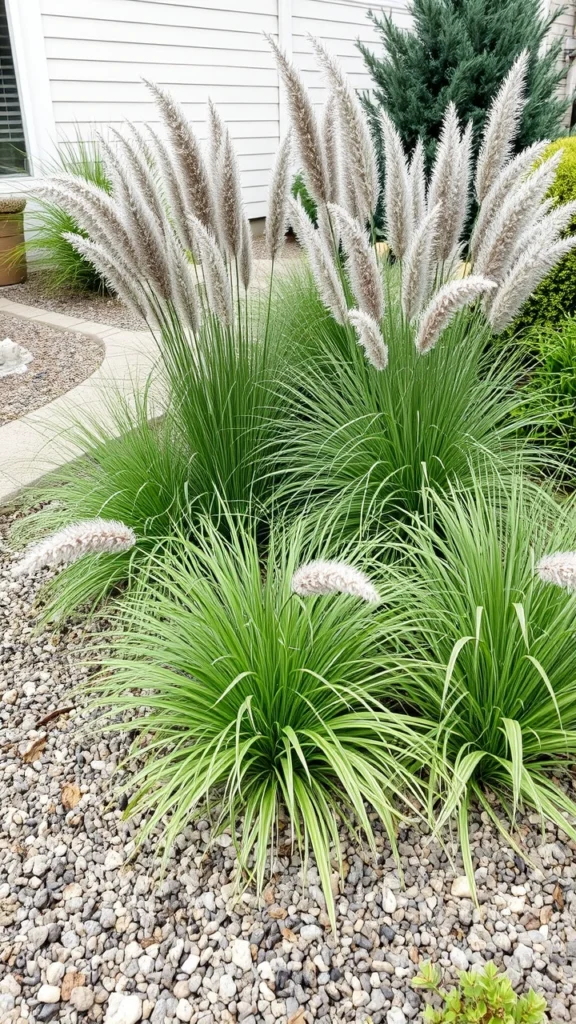
Ornamental grasses bring movement, texture, and an effortless natural vibe to your front yard. They’re also tough as nails when it comes to drought.
Varieties like blue oat grass, fountain grass, and Mexican feather grass are perfect for hot, dry climates. Once they’re established, they need very little water and basically take care of themselves.
Use them as borders, accents, or in clusters for a wild, wind-swept effect. They sway beautifully in the breeze and change with the seasons, offering visual interest all year long—even when they’re not blooming.
Just trim them back once a year, and you’re good. Seriously, they’re some of the easiest plants you’ll ever own.
20. Terracotta Pots
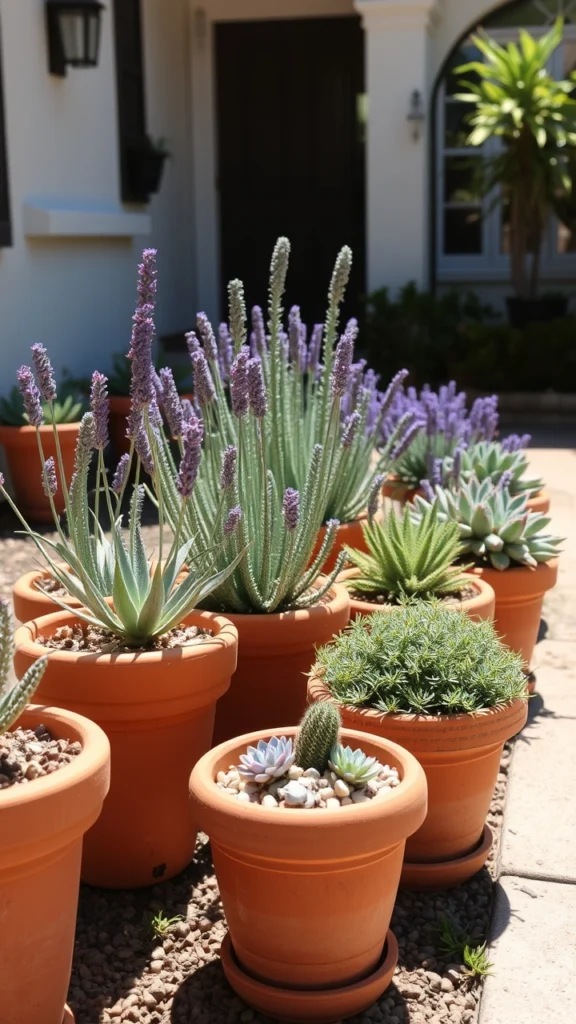
Terracotta pots aren’t just classic—they’re incredibly practical for a drought-tolerant front yard. These breathable clay containers help prevent overwatering by allowing moisture to evaporate naturally, which is great for desert-loving plants.
Use them to spotlight succulents, agave, lavender, or even a small citrus tree. You can group pots together in different sizes and heights for a layered, designer look. Or flank your entryway with a matching pair for symmetry.
They also give you flexibility. Want to refresh your layout seasonally? Just move the pots. Want to avoid digging into hard soil? Done.
Terracotta is timeless, earthy, and totally functional in hot, dry settings.
21. Large Rocks Arrangement
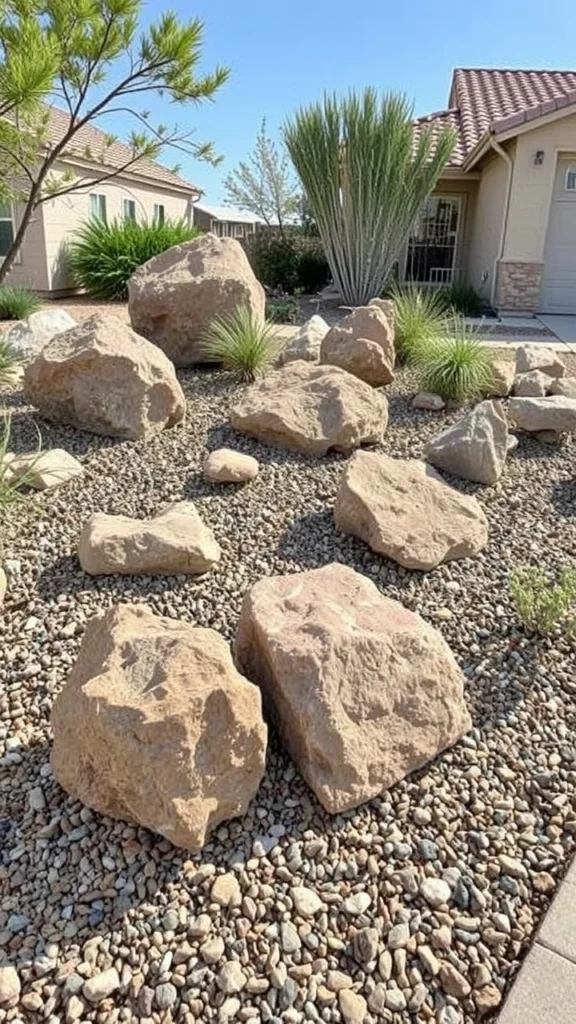
Large rocks can completely change the vibe of your front yard. When arranged thoughtfully, they bring structure, depth, and a grounded, earthy feel to your landscape—without needing a drop of water.
Go for a mix of sizes to make things look natural: a few boulders, some medium rocks, and scatter smaller stones around them. You can create focal points, outline paths, or use them to anchor your plant groupings.
Pair them with gravel, mulch, or groundcover for a balanced, sculptural look. Bonus points if you partially bury them—it makes them look more like natural features than landscaping decor.
It’s a bold yet low-maintenance way to bring shape and interest to your yard.